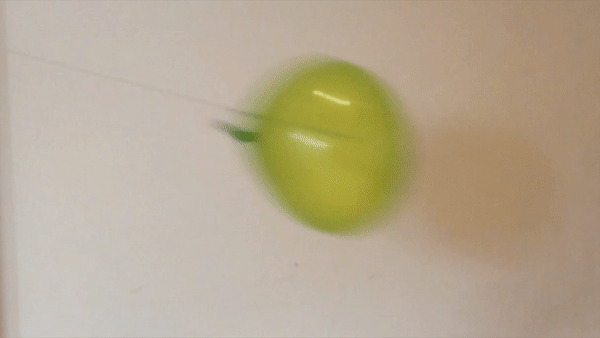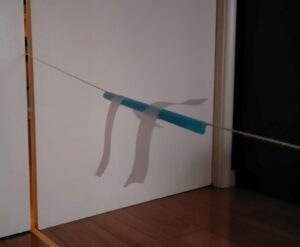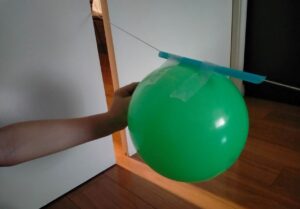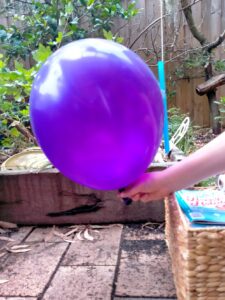Make a rocket with just a balloon, string, straws and sticky tape. See how far and how high you can go.
Learning intentions
Students examine and apply Newton’s law of motion (action and reaction). For older and more advanced students they will learn about Newton’s 2nd law and the relationship between force, mass and acceleration: F=m/a. See experiment 2.
Download pdf of complete Activity with images, worksheet tables and links
Before the experiment
Rockets are critical for space travel*. Although rocket technology has significantly improved overtime, the mechanism of rocket propulsion has remained the same. The force that pushes the rocket upward to the sky is known as thrust and it is the same force that pushes your balloon rocket. The physics stuff here is explained by understanding Newton’s 3rd law of motion, which says that for every action there is an equal and opposite reaction.
*In space there is no oxygen or even air. Any engine that burns fuel, such as jet or car engines, need oxygen (oxidizer) to enable combustion of their fuel and make the engine do work. They get the oxygen from the air around them. Rockets work by burning fuel too, but they can burn their fuel in space because they carry their own oxygen with them in a separate tank. Some rockets use a solid fuel and the oxygen (or similar chemical that acts as an oxidizer) is a component of the solid fuel.
Hypothesis
Experiment 1
You begin with a balloon that you have blown up (inflated). You are going to attach the balloon to a straw that can travel along a length of string. You will release that balloon with a knot in it to prevent air escaping and without the end tied up so the air will escape. In another balloon you will insert a straw into the opening so the air can only escape through the straw. What will happen to the balloon in each case? Make some predictions about the following:
- What will happen to the balloon if you tie the opening to prevent air escaping then let it go? What will the balloon do?
- What will happen if you release the balloon you inflated and attached to your straw without tying a knot to seal the opening?
- What will happen when you release the balloon with the straw in the opening?
- Does the amount of air (volume) you blow into the balloon affect what happens to the balloon once released?
- What will happen to an inflated balloon that is cooled down (eg put into a fridge)?
Experiment 2
In this experiment you have your inflated balloon, but your string will be vertical and you will be adding some weight to the balloon.
- Will the balloon travel up the string as far as it travels along the string in Experiment 1?
- What effect will the extra weight have on the balloon?
Materials
Experiment 1
- String (strong, but thin enough to pass through a straw easily)
- Straws
- Sticky tape
- 3-5 balloons per person or group
Experiment 2
In addition to the materials in Experiment 1, collect the following:
- Small weights, eg 5 and 10 cent coins, or Blutack
Method
Experiment 1
- Find two objects with some weight that you can tie your string between and allow your balloon to be off the ground. For example, heavy wooden chairs, a door and a desk. The string will need a length of about 7-8 metres.
- Thread your string through the straw. Take two pieces of tape and paste it on the outer edge of the straw as shown in Figure 1. Tie your string between the two weighty objects and ensure your string is level and tight (no sag in the middle).
- Bring your straw to one end of the string.
- Inflate your first balloon and secure the end so no air escapes. Attach the balloon to the sticky tape on the straw. Let go of the balloon. What happens? Remove the balloon from the sticky tape.
- Inflate your second balloon, but do not tie off the end. Hold the end so the air cannot escape and attach the balloon to the straw on the string. Release the balloon (Make sure you have attached the balloon so the opening is facing the correct way – you will know if you get it wrong). What happens to the balloon this time?
- Measure the distance the balloon travelled along the string.
- Repeat steps 5 and 6 three more times. Think about why it is important to repeat your test multiple times.
Compare your results for each balloon to the rest of the class. See who can get the balloon to travel the furthest along the string.
Extension
Your air is your fuel supply. Inflate the balloon only half way and see what effect that has on the distance travelled. Repeat three times, recording the distance for each repetition.
Thrust is proportional to how fast the air will escape from the balloon. Insert a short section of plastic straw into the end of the balloon (the bit you place your mouth over to blow it up). Tape it down so that the straw is now the opening that the air in the balloon can escape from and the only way for the air to escape. *Inflate the balloon and let it fly along the string. How does the action of this balloon compare to the balloon with the normal opening (no straw)? Repeat this three times.
*The balloon is harder to blow up through the straw, so you may need help with this.
Temperature and volume
To give you an understanding of the relationship between volume and temperature. Take two identical balloons and as best that you can manage inflate them to an equal size. Secure their ends to prevent air escaping in a way that is easy to release again, eg a strong bulldog clip. Put one in the fridge, the other in a hot place (eg in the Sun).
After 10-15 minutes compare the balloons. Or take one inflated balloon and use a string to measure its circumference at different temperatures. What do you observe? Can you explain what is happening?
See Figure 2 below to help you out here.
Experiment 2. Playing with force, mass and acceleration
In experiment 2 we point the balloon up and you can start to think about and understand the relationship between force, mass and acceleration and how this is critical to get a real rocket off the ground and into space, along with the problems scientists and engineers need to overcome when designing relevant technologies such as rockets, planes, cars, bicycles – anything we want to move.
Remember that the mechanical force that pushes a rocket is called thrust. In this experiment we get to think about Newton’s Second Law that relates to our balloon’s mass (m), its acceleration (a), and the force (F) needed to lift it off the ground. The relationship is expressed in the calculation, F = ma. You will need to consider this relationship to answer the questions in this experiment and work out what is happening in this experiment.
- Find appropriate attachment points to enable your string to run vertically. For example, from the floor to the ceiling or if you are outside, from the ground to an overhanging tree branch. About 3-4 metres of height should be sufficient.
- Attach your string – with straw – between your two attachment points
- Inflate a balloon and attach it to the straw at ground level.
- Release the balloon. Repeat 3 times. Calculate the average height from the three repetitions.
- Inflate another balloon and tape a small weight (eg, a coin) to the balloon (or secure piece of Blutack of known weight to the straw). Release the balloon. Repeat 3 times. Calculate the average height from the three repetitions.
- Add extra weight to the balloon and examine the effect. What weight do you need to add before the balloon can’t get off the ground.
- How high you can get the balloon to go?
- What is the maximum weight you can get onto your balloon and still achieve lift off?
- Compare the average height your balloon achieved in steps 4-6 to the average height achieved by the rest of the class.
Check out the short demo of our vertical balloon rocket below.
Figure 1 (left). Thread your string through the straw and attach it at both ends so the string is straight and tight.
Figure 2 (middle) Use sticky tape to attach your balloon to the straw then launch.
Figure 3. (right) The countdown before launch of the balloon rocket on the vertical string. As in experiment 1, the balloon is taped to the straw that enables the balloon to travel up the string – if there is enough thrust.
Playing around with Newtons Law 2 and 3
Experience Newton’s 2nd and 3rd law on your own body. Grab a basketball. Stand on a skateboard, or sit on an office chair with wheels (a hard, smooth floor is best here. Carpet has too much friction). Throw the basketball and see what happens to your body (and skateboard and chair). If you are standing on the skateboard, make sure you throw the ball toward the front of the skateboard. The basketball will travel in one direction. Which direction did you travel? Did you move at all? If you didn’t move, what made you remain stationary?
Consider the combined mass of your body and the chair or skateboard and think about the relationship between force, mass and acceleration. The greater the mass of the object, the greater the force you will need to apply to it for it to move (accelerate).
What could you do to either make yourself move (if you remained stationary) or move faster and further than before. What are you changing re: force, mass and acceleration to make this happen?
To help get your head around this a bit better test out these ideas. In your chair or on your skateboard, try throwing the basketball with more or less force. Throw a ping pong ball from the chair or skateboard and observe the differences.
What you should notice is that throwing a ping pong ball that has a lot less mass than the basketball will not produce sufficient thrust to make you move in your chair as much as when you threw the basketball.
What is happening
The balloon is mainly propelled by pressure in this experiment. When you blow up a balloon, you are filling the balloon with air molecules that move freely inside the balloon and collide with each other. The more air molecules inside the balloon, the more collisions between the molecules and therefore the greater the pressure in the balloon. There is now a higher pressure inside the inflated balloon than outside the balloon and this higher air pressure in the balloon is what acts as the rocket fuel.
Because air (or gas) will move from regions of high pressure to lower pressure, when you release the opening of the balloon, gas from the balloon is propelled from the inside of the balloon to the outside until the pressure inside the balloon is equal with the pressure outside of balloon.
3rd Law
The air escaping from the inside of the balloon is exerting a force (an action) in one direction (away from the balloon). Newton’s 3rd law of motion says that for this action there should be an equal and opposite reaction. That reaction is an equal force applied to the balloon in the opposite direction from the air expelled from the balloon, which is the thrust that propels the balloon rocket forward.
Thrust is any force that moves an object – in this case your balloon rocket – in the direction of the motion (along the string). For a rocket, its direction of motion is usually up – at least it should be if it wants to get to space. See Figure 4.
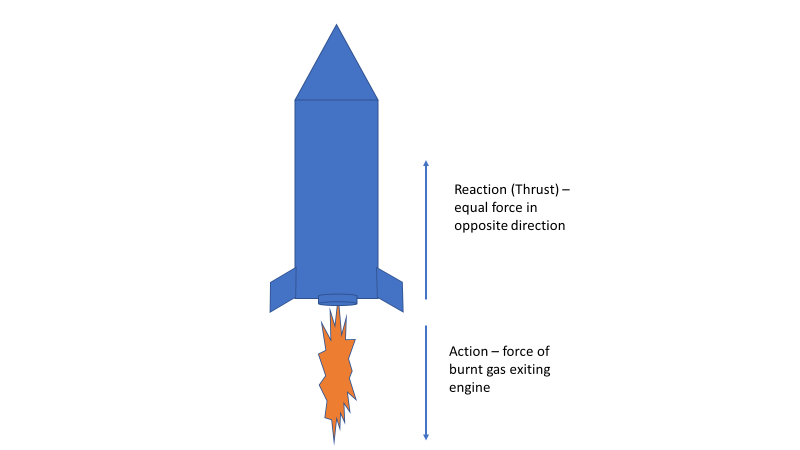
Figure 4. Newton’s 3rd law. The force of the expulsion of the burnt fuel from the rocket creates an equal and opposing force (thrust) that lifts the rocket upwards.
Straw in the balloon
Remember that thrust is proportional to how fast the air will escape from the balloon. Air can only escape slowly through the straw and therefore the thrust will be lower than without the straw. Depending on the diameter of your straw, your balloon may not have had sufficient thrust to move at all (a=0).
Cold versus hot balloon
This is a demonstration of what is known as Charles’ Law, which states that when the pressure of a gas is held constant (such as in an inflated and sealed balloon), increasing its temperature will increase its volume, and decreasing the temperature will decrease its volume. This is conservation of energy also as the energy in the hotter air molecules will transfer to the cooler air molecules in a balloon. With that extra energy, the air molecules in the balloon will start to spread out and take up more space. The opposite occurs when you cool the balloon. That is, the air molecules lose some of their energy and stop jiggling so much, and get closer together (take up less space). See Figure 5. The experiment is way more dramatic if you can get hold of liquid Nitrogen to cool the balloon.
If you have a non-elastic vessel such as a SCUBA tank or LPG bottle, then the volume is constant and heating the gas molecules will increase the pressure inside the vessel. Balloons are elastic and can expand/contract as the volume of gas changes, but the pressure will change a little bit because there is a limit to a balloon’s elasticity, which is why we can use the balloon as a rocket. That is, we can increase the pressure inside a balloon enough to provide thrust.
See Figure 5.
Experiment 2.
The mechanical force that pushes a rocket is called thrust. In this experiment we introduce Newton’s Second Law where we examine the relationship between a balloon’s mass (m), its acceleration (a), and the force (F) to push it up the string. The relationship can be expressed as
F = ma.
The units
Force (F) is measured in newtons (N)
mass (m) is measured in kilograms (kg)
acceleration (α) is measured in metres per second squared (m/s2)
In other words, 1Newton = 1kg×1m/s2
Engineers need to calculate all this to know how big an engine to put in a car or plane – or to make anything move – or importantly also, to stop. Imagine your car with poorly engineered brakes?
Lost your spaceship? Stay cool, use your tool
If you consider the relationship between force, mass and acceleration, the act of throwing the ball is the push force (action) that produces the opposing force (reaction) that propels your body (mass) in the opposite direction. Assuming there is sufficient force to overcome your mass, how far and fast you propel backwards (your acceleration) is determined by your mass and the force you used. Therefore, if you are ever in space doing a spacewalk to do repairs and you become untethered from the spacecraft, you can always throw your tool in the direction opposite to the space craft. The tool should fly off at a fair speed in the direction you threw it (having not much mass) and you (having a lot more mass) should gently coast back to your spaceship.
Essentially, what the relationship, F=ma, tells us is that the acceleration that an object experiences is directly proportional to the applied force and inversely proportional to its mass. This just means that if, for example, you apply twice the force to an object you will double the acceleration of the object, but if you double the mass, the acceleration will halve.
Payload vs fuel
Space ships in Star Trek and Star Wars make it look easy, but to get a rocket off the launch pad, its engine must produce thrust that is greater than the total mass of the rocket, which includes the rocket itself, fuel, astronauts, their food, experimental gear, etc. A general rule for rocket engineers is that of the total mass of the rocket, about 90% of that mass will need to be fuel. Only about 4% of the mass can be the payload ie the stuff you need to get into space such as the astronauts, food and equipment.
At launch therefore, astronauts are sitting on a giant bomb that will go off just to launch them to the edge of the atmosphere. This is why scientists are working on new propulsion systems. Scientists have already found and used the acceleration of ions (charged particles) as a way to create thrust once the spacecraft is actually in space, but unfortunately the thrust from ion drives is too small to get a rocket off the ground. The conventional chemical propellant will have to suffice for now, it seems to get us off the ground.
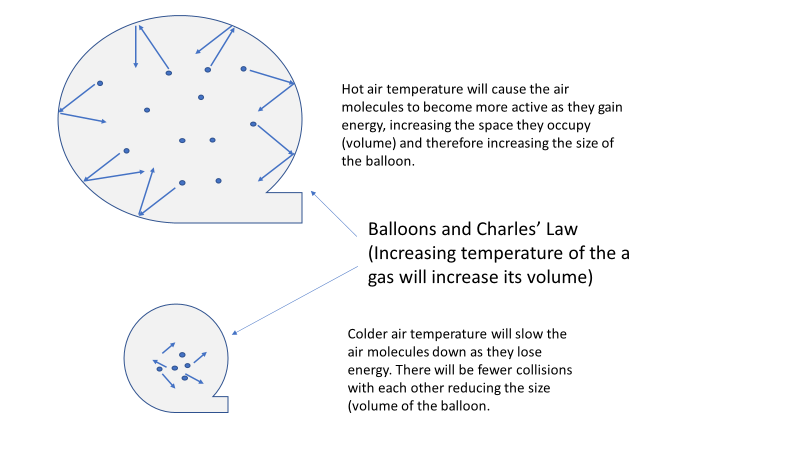
Figure 5. The effects of temperature on volume is visible on an inflated balloon. Heating the air inside a balloon will increase the volume of the gas and therefore the balloon. The opposite happens when you cool the balloon.
Check out NASA’s nice demo below of Newton’s 2nd Law – done on the space station.
Veritasium does another fun demonstration of Newton’s laws here – it demonstrates jet rather than rocket power, but the principles still apply.
For another FLEET home science activity where you can build a rocket, check the Match head rocket activity.
Acknowledgement: The Balloon rocket resource was developed by FLEET PhD students, Abu Parvez and Hien Thi Dieu Nguyen
Back to FLEET Schools or Home Science

